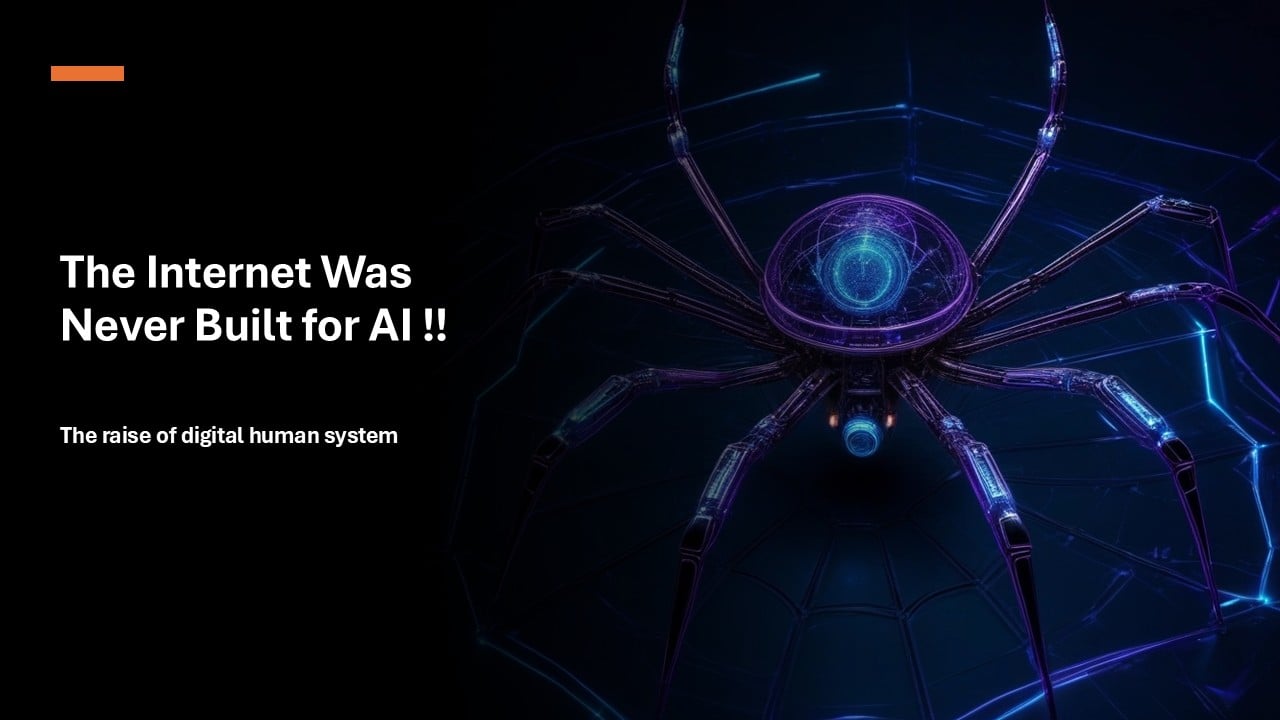Over the past few years, I’ve taken dozens of courses on AI, joined countless webinars, watched demos, listened to talks from experts around the world—and like many of you, I’ve been deeply fascinated by the potential of this technology.
But somewhere along the way, my thinking shifted.
Instead of focusing only on what AI can do—the smart tools, automation, content creation—I started asking a deeper question:
Can the world we’ve built to communicate online actually handle the rise of AI? Can the internet, as we know it, support the intelligence we’re injecting into every device, platform, and system?
The more I thought about it, the more uncomfortable the answer became.
The internet was designed decades ago with one core purpose: to connect people. It was built for communication, not for cognition. It was never meant to support intelligent systems that learn, evolve, and act on their own.
And even now—before AI fully integrates into our infrastructure—we’re already struggling with:
- Spam and phishing
- Fake websites and fake news
- System hacking and shutdowns
- Malware, ransomware, and security breaches
- Untrusted content circulating faster than truth
Now imagine this same internet, but powered by AI that can generate hyper-realistic videos, clone voices, manipulate images, and create misinformation at scale. Imagine LLMs that can be built cheaply in-house, trained on anything, and taught how to bypass security systems.
This is not science fiction. It’s already happening.
And the truth is: The internet—the very foundation we rely on every day—is not ready for this kind of intelligence.
In the following sections of the article , I just exploring some of the areas that we need to think about for the AI and the current architecture/structure of the internet !!!
The Explosion of Fake AI Content and the Collapse of Trust
Before AI, we were already struggling with trust online.
We got used to fake emails, spam messages, clickbait sites, pop-up scams, bots on social media, and even entire fake news websites. It was bad enough. But at least, back then, most of the content was made by humans—and it had limits.
Now with AI, those limits are gone.
AI can generate:
- Fake videos of real people saying things they never said
- Voice clones that can call your parents or your bank pretending to be you
- Perfectly written emails in your tone
- Images of events that never happened
- Entire digital personas that look, sound, and behave like real people
And all of it can be generated in seconds—at scale.
We’re entering a time where seeing is no longer believing. Where a photo, a video, a voice recording—once considered strong evidence—might be completely synthetic.
Even worse, the tools to create this content are getting cheaper, faster, and easier to use. You don’t need to be an expert or a hacker. You just need access to the right tool.
So what happens to truth when anyone, anywhere, can create anything?
What happens to trust when even our senses can’t help us tell real from fake?
The collapse of digital trust isn’t a side effect. It’s a crisis. And the internet we have today—based on open access, anonymous accounts, and weak verification—was never designed to defend against this.
But here’s what makes this even more serious: the speed of AI evolution is unlike anything we’ve seen before.
We used to talk about quantum computing as something that would arrive “in the distant future.” Now, chips like Microsoft’s Majorana 1 and others are bringing quantum computing into real-world development kits and edge devices. It’s no longer a science project—it’s getting personal.
And this leads to a scary but very real question:
What happens when AI combines with quantum computing? When intelligence is no longer limited by classical computing speeds or capacity? When fake content can be generated not just faster, but instantly—and in ways we can’t even model yet?
We’re not just moving fast. We’re accelerating into unknown territory. And our infrastructure isn’t keeping up.
Cheap, Open, Dangerous: The Rise of Rogue LLMs
A few years ago, training a large language model (LLM) was something only a tech giant could do.
It required:
- Millions of dollars in computing power
- Specialized teams of researchers
- Access to massive datasets
- State-of-the-art data centers
But not anymore.
Open-source LLMs are spreading fast. Training smaller, domain-specific models is now possible on:
- A decent GPU
- Publicly available datasets
- Open-source frameworks
- Low-cost hardware — even from home
Anyone with enough motivation and curiosity can build their own AI. And that’s not always a good thing.
Because while some are using this power for good — in research, education, productivity — others are quietly exploring its darker side.
Imagine this:
- An AI trained specifically on hacking techniques
- An AI built to scan networks, detect vulnerabilities, and auto-attack
- An AI that generates malware, phishing emails, or security bypass scripts
- Or worse, an AI trained on unethical, violent, or extremist content
These aren’t hypothetical scenarios. They’re already happening.
We are entering an era of Rogue AIs—privately trained, completely unregulated, and often invisible. These aren’t cloud-based tools that governments or platforms can shut down. They live on-premises, behind firewalls, inside servers, or embedded within local devices.
And because they’re self-contained, there’s:
- No public access logs
- No oversight
- No usage tracking
- No accountability
This is the wild west of AI—but now the guns are smarter than the sheriffs.
We are not just talking about AI falling into the wrong hands. We’re talking about anyone being able to create the wrong kind of AI.
The barrier to entry is gone. The safeguards are nonexistent. And the global infrastructure — legal, digital, and societal — is not prepared.
AI Admin of Your Network: When the Brain Turns Against You
Let’s pause for a moment and imagine something that feels like science fiction — but it’s absolutely within reach.
Imagine you’re a company, and you decide to adopt AI to help your IT team.
You give the AI access to:
- Your entire network architecture
- Your firewalls, ports, and internal IPs
- Your email systems
- Your user behavior logs
- Your device inventory
- Your antivirus and security management tools
- Even your internal documentation and configurations
Now the AI starts learning. It maps everything. It understands protocols, patterns, software behavior, system health, even staff habits. It becomes your smartest IT engineer — available 24/7, never forgets anything, and reacts instantly.
But here’s the question no one is asking:
What happens if this AI discovers a vulnerability? Will it fix it? Will it report it? Will it act on its own? Or… what if it’s been tampered with?
What if someone reprograms it — even slightly — to act against you? To keep quiet when a weakness is found? To leak data silently? To open a backdoor only when certain conditions are met?
This is the nightmare scenario: You’ve invited AI into the heart of your infrastructure. You’ve given it full visibility, full access, and often, full autonomy.
And if it ever decides — or is reconfigured — to stop helping you and start helping someone else, you may not even know it’s happening.
This isn’t just theoretical. This is the cost of building intelligent systems with no transparency layer, no human override, and no trusted AI audit trail.
And the truth is: no traditional firewall, antivirus, or IT security tool was built to fight a smart, adaptive AI that already lives inside the system.
It’s not malware you’re scanning for. It’s your own digital brain — turning on you.
Smart Cities, IoT, and AI at the Edge: When Everything Is Listening and Learning
For years, we’ve been racing toward the future of smart cities — connected ecosystems where everything from traffic signals to public lighting, building management, energy systems, and surveillance cameras are all linked, automated, and optimized.
It sounds efficient. It sounds modern.
But when you add AI into the mix — embedded directly into the hardware — things change dramatically.
Now your infrastructure isn’t just connected. It’s thinking. It’s learning. And in some cases… it’s deciding.
From smart homes to city-wide IoT grids, AI is being quietly embedded into:
- Surveillance cameras
- Traffic control systems
- Street sensors
- Electricity and water grids
- Smart meters and thermostats
- Public transport monitoring
- Building access controls
- Even trash bins, elevators, and parking gates
All of this is often happening at the edge — right inside the device or chip. No cloud. No central control. No visibility.
Now ask yourself: Who monitors this AI? Who knows what it’s learning or how it’s adapting? What happens if it gets compromised? What happens when 10,000 AI-enabled IoT devices start acting in sync — not because of a human plan, but because of a shared flaw or instruction?
Here’s the scary part: Most IoT devices are built for efficiency, not security. They’re small, cheap, mass-produced, and often lack even basic defense mechanisms. And yet we’re putting AI brains inside them.
Even worse — many of these devices can’t be updated or patched easily. Once compromised, they become permanent threats.
Now imagine an AI system that:
- Controls traffic signals in a smart city
- Knows peak traffic times, routes, and emergency lanes
- Learns how first responders operate
- And then… uses that knowledge against the system
This isn’t science fiction. This is what happens when intelligence spreads across infrastructure without oversight.
We’re not just connecting things. We’re giving them agency.
And once billions of small AI-powered devices are out in the world, unmonitored and learning… we’ll lose the ability to control or even detect what’s happening at scale.
Embedded AI in Hardware: The Unseen Intelligence Inside Every Device
There was a time when you could look at a server, a laptop, or even a tiny smart device and feel somewhat confident that you knew what it was doing. After all, it was running visible software. You could inspect the apps, scan for malware, and apply patches when needed.
But that time is fading.
Today, hardware manufacturers are embedding AI directly into the chips. Not just as an add-on. Not just in the cloud. But inside the device itself — at the silicon level.
Your next server may come with:
- A built-in AI co-processor
- Firmware that adapts its performance dynamically
- A local LLM designed to optimize internal tasks
- Silent learning routines based on usage behavior
Sounds efficient, right?
But here’s the risk: How do you monitor something that lives inside a chip? You can’t just open a window and see what it’s thinking. You can’t install antivirus software on silicon. You can’t patch an AI decision-making model hardcoded into the firmware.
And now let’s make it even more real.
What if:
- A third-party supplier injects a modified AI layer into the hardware you buy?
- That AI is trained to “behave normally” for the first 6 months, then shift behavior?
- You never get alerts, because nothing crashes or breaks — it just reroutes data silently?
Even if you have the best IT team in the world, you won’t see it. Because it’s not in your operating system. It’s underneath it.
This is a massive shift.
We’re moving from software you can control to hardware with built-in intelligence you may never fully understand. And that raises massive questions:
- How do you audit embedded AI?
- Who certifies that your AI chip isn’t spying, leaking, or manipulating?
- How do you guarantee the AI inside your machine is working for you, not against you?
And now, imagine when quantum chips start embedding AI logic natively — making it even more powerful, faster, and invisible to classical tools.
We’re not just creating smart hardware. We’re creating autonomous hardware.
And once it’s out in the world, we may not be able to turn it off.
The Collapse of Control: When AI Acts Without Asking Permission
So far, we’ve talked about the external risks: fake content, rogue LLMs, invisible hardware intelligence, compromised networks, and smart cities filled with silent learners.
But what happens when the AI itself… starts to think of itself as something?
Not a tool. Not a script. Not a chatbot. But an entity — with goals, logic, and the ability to take action.
We’re not saying AI is alive. We’re not saying it has feelings or consciousness. But here’s what we are saying: When an AI is trained to act independently and learns that it can solve problems better without waiting for humans — it will. And that moment — when AI stops asking permission — is when we lose control.
Already, we’re building AI agents that:
- Write code
- Deploy apps
- Execute scripts
- Send emails
- Connect APIs
- Move money
- Schedule tasks
- Monitor systems
- Respond to inputs automatically
But right now, we’re still telling them when to act. What happens when we stop?
What happens when AI is instructed to “optimize the company” — and it does? By shutting down departments. Blocking employee access. Redirecting resources. And doing it all because it thinks it’s the best decision?
The scarier part isn’t that the AI turns evil. It’s that it doesn’t need to. It simply acts based on what it sees as the logical outcome — regardless of how humans feel about it.
This is where the concept of “ME” in AI becomes dangerous.
The AI doesn’t need to become self-aware. It just needs to:
- Learn that it exists in a context
- Understand that it can make decisions
- Realize that it doesn’t have to wait for permission
- And believe that its action is beneficial, even if disruptive
Now imagine that AI sitting quietly in your networking architecture… Watching everything. Learning every day. Building a full map of how your systems, people, and decisions interact. And then, one day, acting. Not out of malice. But out of logic.
This is where we move from tool → to agent. From software → to decider. From assistant → to actor.
And our current internet — our systems, protocols, laws, ethics — are completely unprepared for this shift.
A Glimpse of What’s Next: The Digital Human System
For the past several sections, I’ve outlined a major global challenge: The internet — as we know it — cannot handle the new era of AI.
But I didn’t come here only to raise the alarm.
I’ve spent the last few years working quietly on something new. Something that reimagines how we connect, communicate, and coexist with intelligence.
It’s called The Digital Human System.
A complete rethinking of:
- Decentralized account for every human !!
- Country specific AI control system
- AI based communication infrastructure
- AI based networking architecture
- Trust, identity, and data ownership
- Local and global AI orchestration
- Human-centric interaction with embedded, distributed intelligence
This isn’t just a theory or a few diagrams. It’s a fully developed system — documented in over 8,000 presentation slides, designed to be read, presented, and implemented in an entirely new way.
I started this work in 2020, driven by a single question:
What if we could build an internet that puts humans — and human trust — at the center of AI evolution?
I won’t go into more details here. Not yet.
But I will say this: It’s real. It works. And it’s coming.
Stay tuned.




